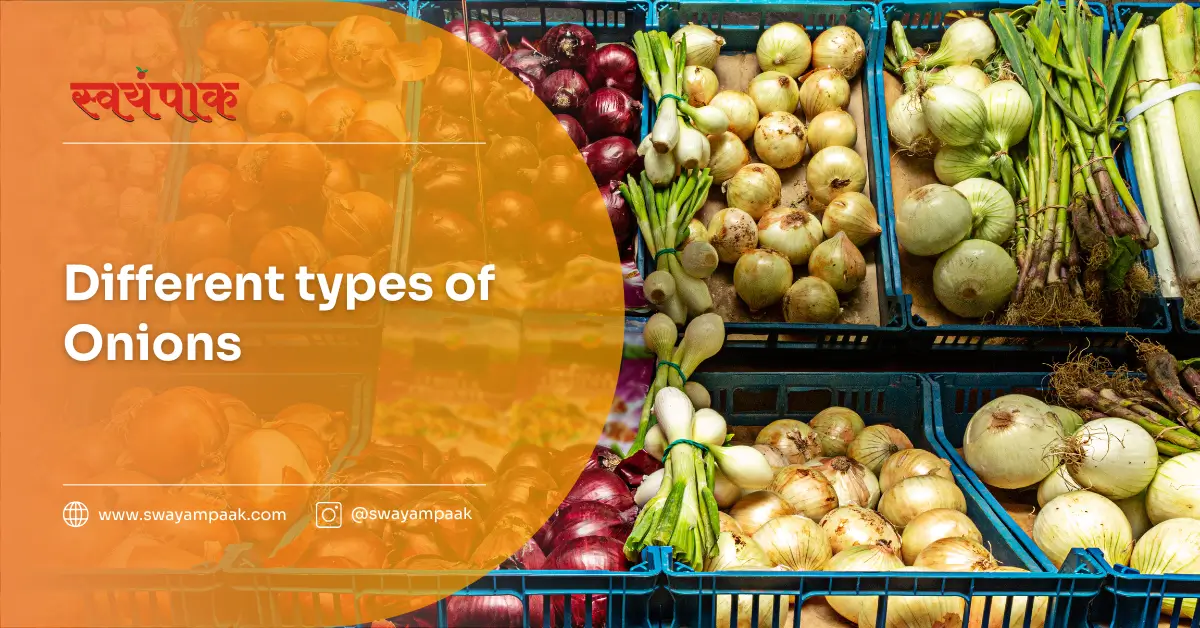Onions, which are members of the genus Allium along with garlic, leeks, and shallots, are among the most important and adaptable ingredients in world cuisine. The different types of onions can alter any meal with their nuanced flavour profiles, which range from mild and sweet to sharp and pungent.
This thorough guide examines the different types of onions, their best applications, how to store them, and their nutritional advantages.
Different types of Onions
Storage Onions, or Yellow Onions
Strong sulphur compounds, white flesh with a yellow tint, and golden-brown papery skin are some of its characteristics.
Flavour Profile: Sharp when raw, sweet and mellow when cooked.
Peak Season: All year long; freshest from August to October
Storage Life: 2–3 months under ideal circumstances
Greatest Applications
- Basis for cooking: Soups, stews, braises, and sauces
- Caramelising: Their high sugar content produces delicious caramelised onions
- Roasting: Develops rich, nuanced flavours
- French onion soup: The traditional option
Cooking Advice
Yellow onions are perfect for recipes where you want the onions to break down and become part of the dish because they release more moisture when cooked.
Purple Onions (Red Onions)
Features include deep purple-red skin, white flesh with red rings, and a high anthocyanin content.
Flavour Profile: Sharp and peppery when raw, but mild and sweet when cooked.
Highest Time of Year: Year-round availability; best summer harvest
Storage Life: 1–2 months
Greatest Uses
- Uncooked applications: Salads, salsas, sandwiches, and garnishes
- Pickling: Preserves colour and texture
- Grilling: Gorgeous caramelisation and colour retention
- Mediterranean cuisine: A must in Middle Eastern and Greek salads
Health Benefits
Anthocyanins give onions a higher antioxidant content than other types.
White Onions
Features: Crisp texture, papery white skin, pure white flesh, and milder sulphur compounds
Flavour Profile: Sweeter and milder than yellow onions
Peak Season: Year-round, with spring and summer being the peak seasons
Storage Life: 1–2 months
Best Uses
- Mexican cuisine: Traditionally used in tacos, guacamole, and salsas
- Raw dishes: Less strong flavour for salads and sandwiches
- White sauces: Won’t discolour white dishes or cream sauces
- Asian cuisine: Preferred in many soups and stir-fries
Sweet Onions
Varieties: Vidalia (Georgia), Walla Walla (Washington), Maui (Hawaii), Texas 1015
Features: Big, flattened shape, high water and sugar content, low sulphur
Flavour Profile: Very mild, sweet, and crisp
Peak Season: Spring through early summer (short season)
Storage Life: 1–2 weeks (high water content speeds up spoiling)
Best Uses
- Raw eating: Great on salads, burgers, or eaten raw
- Light sautéing: Quick cooking to retain sweetness
- Onion rings: Thick rings and mild flavour make them perfect
- Roasting whole: Highlight their inherent sweetness
Because of their high moisture content, sweet onions should be used right away and do not keep well in storage.
Scallions (Spring/Green Onions)
Features: Harvested young, tiny white bulbs, long green tops
Flavour Profile: Mild onion flavour, with varying intensities in different parts
Best Seasons: Spring and autumn, but it’s available all year round
Storage Life: 1 week in the refrigerator
Uses and Parts
- White and light green parts: A Stronger flavour is good for cooking
- Dark green tops: Milder, ideal for garnish
- Whole scallion: Asian marinades, soups, and stir-fries
Cooking Uses
- Garnish: Chopped tops for Asian dishes, baked potatoes, and soups
- Stir-frying: Rapid cooking preserves crisp texture
- Grilling: Coat with oil and grill whole as a side dish
Shallots
Features: Copper-coloured, small, elongated bulbs that frequently grow in clusters
Flavour Profile: Subtle, complex, and more sophisticated than onions with hints of garlic
Availability: All year round, with the autumn harvest being the peak season
Storage Life: 2–3 months
Best Uses
- French cuisine: Essential in béarnaise sauce, mignonette, and vinaigrettes
- Fine dining: Where delicate onion flavour is required without being overpowering
- Sautéing: Quick cooking preserves delicate flavour
- Raw preparations: Minced in dressings and marinades
Preparation Advice
There are usually two to three easily separated cloves per shallot bulb.
Leeks
The mild onion family member has large, thick white stalks with long green leaves.
Flavour Profile: Very mild, sweet and delicate
Peak Season: Autumn to early spring
Storage Life: 1–2 weeks in the refrigerator
Components and Applications
- White and light green portions: Mild and tender, utilised in cooking
- Dark green uppers: Flavourful but tough, suitable for soups and stocks (remove before serving)
Necessary Preparation
Leeks retain dirt between their layers; cut them lengthwise and give them a good rinse under running water.
Classic Uses
- Potato Leek Soup: Traditional French cooking
- Braising: Great braised in butter or stock
- Stocks: Green tops give depth to chicken and vegetable stocks
- Quiche and tarts: Mild flavour goes well with cheese and eggs
Pearl Onions
Features: White, yellow, or red onions that are small and marble-sized
Taste Profile: Mild and sweet, resembling larger onions but more delicate
Peak Season: Autumn
Storage Life: Two to three months
Greatest Uses
- Braising: Traditional in coq au vin and beef bourguignon
- Pickling: Conventional cocktail onions
- Roasting: Beautifully caramelise in the oven
- Stews: Add whole to preserve shape and appearance
Preparation Advice
Blanch in boiling water for one minute, then move to ice water to make peeling easier.
Different types of Onions and their uses in India
A flavorful journey of different types of onions through India’s diverse culinary traditions
Maharashtra
Western India
Signature Dishes
- Vada Pav: Deep-fried onions in spiced potato fritters
- Bhel Puri: Finely chopped raw onions for crunch
- Misal Pav: Caramelized onions in spicy curry
- Kanda Poha: Flattened rice with golden-fried onions
- Puran Poli: Sweet onions in traditional preparations
Preferred Onion Types:
Red Onions: For raw preparations like salads and chutneys. Yellow Onions: For cooking and street food. Maharashtra is known for its extensive use of onions in both sweet and savory dishes.
Punjab
Northern India
Signature Dishes
- Butter Chicken: Rich onion-tomato gravy base
- Sarson da Saag: Slow-cooked onions with mustard greens
- Chole: Caramelized onions in chickpea curry
- Rajma: Onion-based kidney bean curry
- Aloo Gobi: Onions with potatoes and cauliflower
Preferred Onion Types:
Yellow Onions: Extensively used for rich, creamy gravies. White Onions: In dairy-based dishes to maintain color. Punjab cuisine relies heavily on slow-cooked onions for depth.
Tamil Nadu
Southern India
Signature Dishes
- Sambar: Pearl onions in lentil curry
- Rasam: Onions in tangy tomato broth
- Chettinad Chicken: Shallots in spicy masala
- Vendakkai Curry: Okra with small onions
- Pongal: Caramelized onions with rice and lentils
Preferred Onion Types:
Shallots (Small Onions): Extensively used whole in curries. Pearl Onions: Traditional in sambar and rasam. South Indian cuisine favors smaller onion varieties for authentic taste.
West Bengal
Eastern India
Signature Dishes
- Macher Jhol: Onions in light fish curry
- Aloo Posto: Onions with potatoes and poppy seeds
- Kosha Mangsho: Slow-cooked onions in mutton curry
- Begun Bhaja: Onions with fried eggplant
- Khichuri: Onions in rice-lentil comfort food
Preferred Onion Types:
Red Onions: For fish preparations and pickles. White Onions: In subtle vegetarian dishes. Bengali cuisine uses onions sparingly to let other flavors shine.
Rajasthan
Northwestern India
Signature Dishes
- Dal Baati: Onions in lentil curry with baked bread
- Laal Maas: Red onions in spicy mutton curry
- Gatte ki Sabzi: Onions with gram flour dumplings
- Ker Sangri: Wild onions with desert beans
- Pyaaz Kachori: Fried pastry stuffed with spiced onions
Preferred Onion Types:
Red Onions: For robust flavors that complement spicy dishes. Dried Onions: Used in preservation techniques. Rajasthani cuisine maximizes onion flavors for harsh desert conditions.
Gujarat
Western India
Signature Dishes
- Dhokla: Fermented batter with onion tempering
- Undhiyu: Mixed vegetables with baby onions
- Khandvi: Gram flour rolls with onion garnish
- Fafda: Fried snack with onion chutney
- Gujarati Thali: Multiple dishes featuring different onion preparations
Preferred Onion Types:
White Onions: For subtle sweetness in vegetarian dishes. Pearl Onions: In traditional vegetable medleys. Gujarati cuisine balances onion flavors with jaggery and tamarind.
Kerala
Southern India
Signature Dishes
- Fish Curry: Shallots in coconut-based curry
- Avial: Mixed vegetables with onions and coconut
- Beef Fry: Caramelized onions with spiced beef
- Appam: Fermented rice pancakes with onion stew
- Puttu: Steamed rice cake with onion curry
Preferred Onion Types:
Shallots: Traditional choice for authentic Kerala flavors. Red Onions: For fish and meat preparations. Kerala cuisine uses onions to balance the richness of coconut milk.
Andhra Pradesh
Southern India
Signature Dishes
- Biryani: Layered rice with fried onions (birista)
- Gongura Mutton: Sorrel leaves with caramelized onions
- Pesarattu: Green gram pancake with onion topping
- Chicken 65: Spicy fried chicken with onion garnish
- Gutti Vankaya: Stuffed eggplant with onion masala
Preferred Onion Types:
Red Onions: For intense flavors and deep-fried birista. Pearl Onions: In traditional curries. Andhra cuisine uses onions to balance extreme heat with sweetness.
Nutritional Data and Health Advantages
Overall Nutritious Profile (per 100g of raw onion)
- 40 calories
- 9g of carbohydrates
- Fibre: 1.7g
- Vitamin C: 7.4 mg (8% DV)
- Folate: 19 mcg
- Potassium: 146 mg
Health Benefits
- Antioxidants: Quercetin and sulphur compounds promote heart health
- Anti-inflammatory: May help lower inflammation markers
- Blood sugar: May help control blood glucose levels
- Bone health: Some research indicates good effects on bone density
- Antimicrobial: Natural compounds may have antibacterial qualities
Seasonal Selection and Availability
What to Search For
The exterior is dry and firm, with no soft spots. They are heavy for their size, have tight, papery skin free of dark spots, and have no green shoots or sprouting (apart from scallions). A subtle, fresh scent (a strong smell denotes spoiling)
Seasonal Guide
- Spring: Sweet onions, scallions, leeks
- Summer: Red onions, sweet onions
- Fall: Storage onions (yellow), shallots, pearl onions
- Winter: Storage varieties, leeks
Applications of Global Cuisine
- Asian cuisine: Scallions for garnish, white onions in stir-fries, shallots in Thai cuisine
- Mediterranean: Red onions in Greek salads, white onions in Italian dishes
- Mexican: White onions in salsas and tacos, red onions for pickling
- Indian: Yellow onions as a base for curries, shallots in South Indian dishes
Essentials of Storage and Preparation
General Storage Recommendations
Whole onions should not be kept in plastic bags but rather in a cool, dry, and well-ventilated place. Keep potatoes and onions apart because they deteriorate more quickly.
Cut onions can be kept in the refrigerator for up to seven days in airtight containers. Frozen diced onions keep well in cooked dishes and last six to eight months.
Preparation Advice
To lessen tears, chill the onions for half an hour before slicing them with a sharp knife and cutting them close to running water. To soften the sharpness of raw onions, soak slices in cold water for ten to fifteen minutes. Cut onions evenly to ensure even cooking.
Wrap-up
You can choose any of the different types of onions for your cooking needs by being aware of their distinctive qualities. Every type of onion has a place in the kitchen, from the strong flavour of yellow onions, which are the foundation of innumerable recipes, to the delicate sweetness of shallots, which enhance fine dining dishes.
You can maximise the flavour and nutritional value of these vital ingredients by using the right preparation and storage methods. The correct type of onion can make the difference between a good and an outstanding dish, whether you’re using it as the base for a complex sauce or to create the ideal garnish.
Try a variety to see how these common vegetables can improve your cooking.


